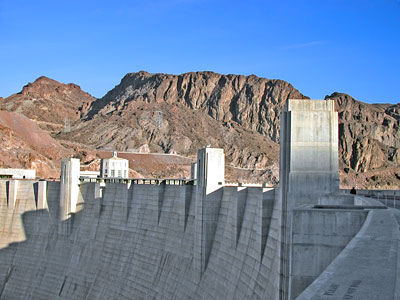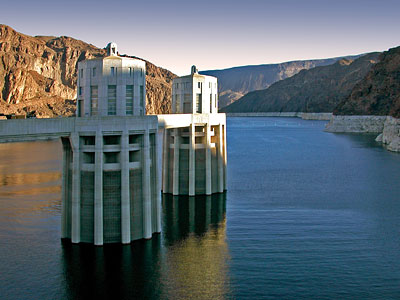National Register of Historic Places in Clark County
Hoover Dam
Highway 93
Lake Mead National Recreation Area
Built 1933-1935
Hoover Dam is located in the Black Canyon on the Colorado River twenty-eight miles southeast of Las Vegas. The west wall of Black Canyon is in Clark County, Nevada, and the east wall is in Mohave County, Arizona.
The drainage area "above Hoover Dam comprises 167,800 square miles including parts of the states of Wyoming, Utah, Colorado, Nevada, Arizona, and New Mexico.
The Colorado River above Hoover Dam rises in the Rocky Mountains of Wyoming and Colorado and flows southwestward to Lake Mead for a distance of about nine hundred miles. Principal tributaries of the Colorado River that feed into Lake Mead are the Green, Yampa, White, Uinta, Duchesne, Price, San Rafael, Muddy, Fremont, Escalante, Gunnison, Dolores, San Juan, Little Colorado, and Virgin Rivers.
The construction of Hoover Dam began June 6, 1933 and was completed September 30, 1935, two years ahead of schedule. Hoover Dam is a concrete, arch-gravity storage dam. The water load in this type of dam is carried by both gravity action and horizontal action.
Curbing the Colorado River by means of building Hoover Dam was the greatest task in hydraulic engineering that had been attempted since digging the Panama Canal.
The proposed dam to be built in the Black Canyon had to achieve several purposes:
- to protect the low-lying valleys of Arizona and southern California from floods
- to store the annual spring runoff for later use
- to solve the problem of the vast amounts of sediment carried by the river
- to provide power generation sufficient to assure repayment of the project
To achieve the goals stated above, a huge dam would have to be built. Hoover Dam was the highest dam in the world - 726.4 feet from bedrock to the crest. A structure of this height would create a reservoir large enough to store safely the normal flow of the river for two years and create the largest artificial lake in the world measured by volume.
The proposed dam was of such magnitude that there was serious opposition and concern about the engineering expertise needed. Questions were raised concerning the possibility of the collapsing of the dam.
Along with the engineering problems were other factors. The extreme remoteness of the damsite, the ruggedness of the terrain surrounding the site, and the extreme climatic conditions; summer temperatures of 125º in the canyon, cloud bursts, high winds and sudden floods all made the work difficult.
Source: NRHP Nomination Form

President Franklin Roosevelt came into office during the worst depression the nation had ever known. Fulfilling a campaign promise to put people to work, he instituted the New Deal to bring economic recovery to the depression-wrought country.
The National Industrial Recovery Act (NIRA) of 1933 authorized the Public Works Administration (PWA) to provide jobs, stimulate business activity, and increase purchasing power through the construction of permanent and socially useful public works. The Federal Government and local city, county and state governments formed a working partnership resulting in the greatest single construction program in history.
PWA construction projects, in addition to providing employment for the skilled, generated a volume of jobs for the unskilled. The PWA provided loans and grants up to forty percent of the total cost of the project to states, and many other public bodies, including schools.
From 1933-1935, the PWA underwrote projects in 3,040 of the 3,073 counties in all forty-eight states. Of the 3.76 billion dollars of
the NIRA fund, 2.56 billion dollars was spent on 19,004 construction projects.
Narrative adapted in part from the NRHP nomination for Tulare Union High School Auditorium and Administration Building
dated 16 November 1999.
Many buildings funded by the PWA have been recognized for their historic significance and architectural excellence. Among them are:
California
Adobe Chapel of the Immaculate Conception in San Diego
Aquatic Park in San Francisco
Beach Chalet Murals in San Francisco
Big Basin Redwood State Park Headquarters Building
Big Creek Bridge in Big Sur
Feather River Scenic Byway Tunnels
Federal Building in Merced
Federal Writers and Artists Projects in San Francisco
Gasquet Ranger Station
Mariposa County High School Auditorium
McClatchy Senior High School in Sacramento
Monterey County Courthouse in Salinas
Mountain View Adobe
Police Headquarters, Jail & Courts in San Diego
Rincon Annex Post Office in San Francisco
Sacramento Junior College
San Francisco State Teachers College
Sitka Main Post Office and Court House in Alaska
Sonora Youth Center
Stanislaus Forest Experiment Station
Sunshine School in San Francisco
The Fort in Taft
Theodore Judah School in Sacramento
Tulare Union High School
Nevada
Carson City Civic Auditorium
Hoover Dam
Southside School in Reno
Tonopah Main Post Office
USO Building in Hawthorne
Yerington Main Post Office
New Mexico
National Park Service Southwest Regional Office in Santa Fe
New Mexico School for the Deaf Building 2 in Santa Fe
New Mexico School for the Deaf Hospital in Santa Fe
New Mexico Supreme Court in Santa Fe
Oregon
Butte Falls Ranger Station in Butte Falls
Dead Indian Soda Springs Shelter in Rogue River National Forest
Fish Lake Shelter in Rogue River National Forest
Gold Beach Ranger Station
Lake of the Woods Ranger Station in Fremont-Winema National Forest
Lithia Park in Ashland
McKee Bridge Campground in Rogue River National Forest
Wrangle Gap Shelter in Rogue River National Forest
Utah
Bryce Canyon Airport
Dalton Wells Civilian Conservation Corps
Minersville City Hall
Rock House in Arches National Park

